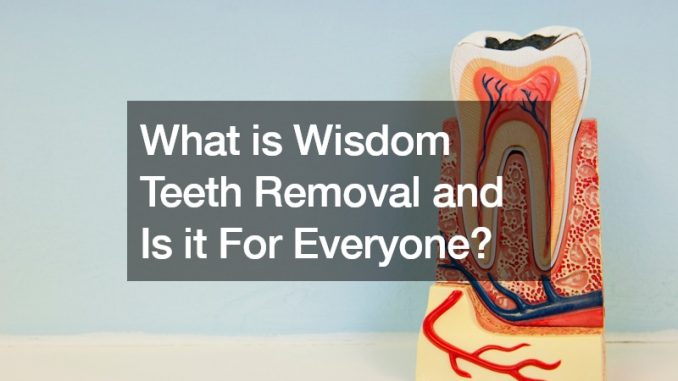

Wisdom teeth, also known as third molars, are the last set of teeth to emerge in humans, typically appearing between the ages of 17 and 25. While these teeth served a purpose in our evolutionary past, many individuals today lack sufficient space in their jaws for them to grow properly. As a result, wisdom teeth often become impacted, leading to various dental issues necessitating their removal.
Common Issues Associated with Wisdom Teeth
Impacted wisdom teeth can cause a range of problems, including pain, swelling, bleeding, and bad breath. In more severe cases, they may contribute to teeth crowding, deformation, cavities, cysts, infections, and even the loss of neighboring teeth.
Therefore, it’s essential to address these issues promptly through wisdom teeth removal to prevent further complications.
Pre-Extraction Assessment
Before undergoing wisdom teeth removal, patients typically undergo a thorough assessment, which may include X-rays to evaluate the position, size, and orientation of the wisdom teeth. This evaluation helps the dental specialist determine whether extraction is necessary and plan the procedure accordingly.
Anesthesia Options for Comfort
To ensure patient comfort during wisdom teeth removal, various anesthesia options are available:
Local Anesthesia: This numbs the extraction area, allowing patients to remain awake during the procedure while experiencing minimal discomfort.
Sedation Anesthesia: Administered intravenously, sedation anesthesia induces a state of relaxation and reduced consciousness, making the patient feel drowsy and less aware of the procedure.
General Anesthesia: Reserved for more complex cases or patients with severe anxiety, general anesthesia renders the patient unconscious throughout the procedure, ensuring they feel no pain or discomfort.
The Wisdom Teeth Extraction Process
The actual extraction process involves several steps:
Incision and Access: The dentist makes incisions in the gum tissue to expose the wisdom teeth and surrounding bone.
Sectioning (if necessary): In cases where the teeth are impacted or difficult to access, they may be divided into smaller pieces to facilitate removal.
Extraction: Specialized instruments like elevators and forceps are used to carefully extract the teeth from their sockets.
Closure: Following extraction, the surgical site may be stitched closed, and a filling may be placed to aid healing and prevent complications.
Post-Operative Care and Recovery
Proper post-operative care is crucial for a smooth recovery, including:
Taking prescribed medications to manage pain and prevent infection.
Avoiding physical exertion and consuming soft foods to facilitate healing.
Refraining from smoking and alcohol consumption, which can hinder the healing process.
Maintaining good oral hygiene practices, including gentle brushing and rinsing with a saltwater solution.
Applying ice packs to the cheeks to reduce swelling and discomfort.
Considerations Before Wisdom Teeth Removal
While wisdom teeth removal is a common procedure, it may not be necessary for everyone. Some individuals may have sufficient space in their jaws to accommodate wisdom teeth without causing problems. However, for those experiencing issues such as pain, crowding, or complications associated with impacted wisdom teeth, extraction may be recommended to alleviate discomfort and prevent further oral health issues.
The Importance of Professional Guidance
Ultimately, the decision to undergo wisdom teeth removal should be made in consultation with a qualified dental professional. Dentists and oral surgeons have the expertise to assess each patient’s unique situation, considering factors such as the position of the wisdom teeth, the potential for complications, and the individual’s overall oral health. By seeking professional guidance, patients can make informed decisions about their dental care and ensure the best possible outcomes.
Addressing Patient Concerns and Questions
It’s natural for patients to have concerns and questions about wisdom teeth removal, particularly regarding the procedure’s safety, efficacy, and potential risks. Dentists and oral surgeons play a crucial role in addressing these concerns, providing patients with accurate information, and alleviating any anxieties they may have. Through open communication and patient education, dental professionals can empower individuals to take proactive steps towards maintaining their oral health and well-being.
Exploring Alternative Treatment Options
In some cases, wisdom teeth removal may not be the only solution to address dental issues related to third molars. Depending on the specific circumstances, alternative treatment options may be available, such as orthodontic interventions to address teeth crowding or periodontal therapies to manage infections and inflammation. Dentists can work closely with patients to explore these alternatives and develop personalized treatment plans tailored to their needs and preferences.
Wisdom teeth removal is a common dental procedure aimed at addressing issues associated with the emergence of third molars. By understanding the purpose of the procedure, the extraction process, and the importance of professional guidance, individuals can make informed decisions about their oral health care. By seeking timely treatment and following post-operative instructions, patients can effectively manage the extraction process and promote optimal oral health and well-being.
.
